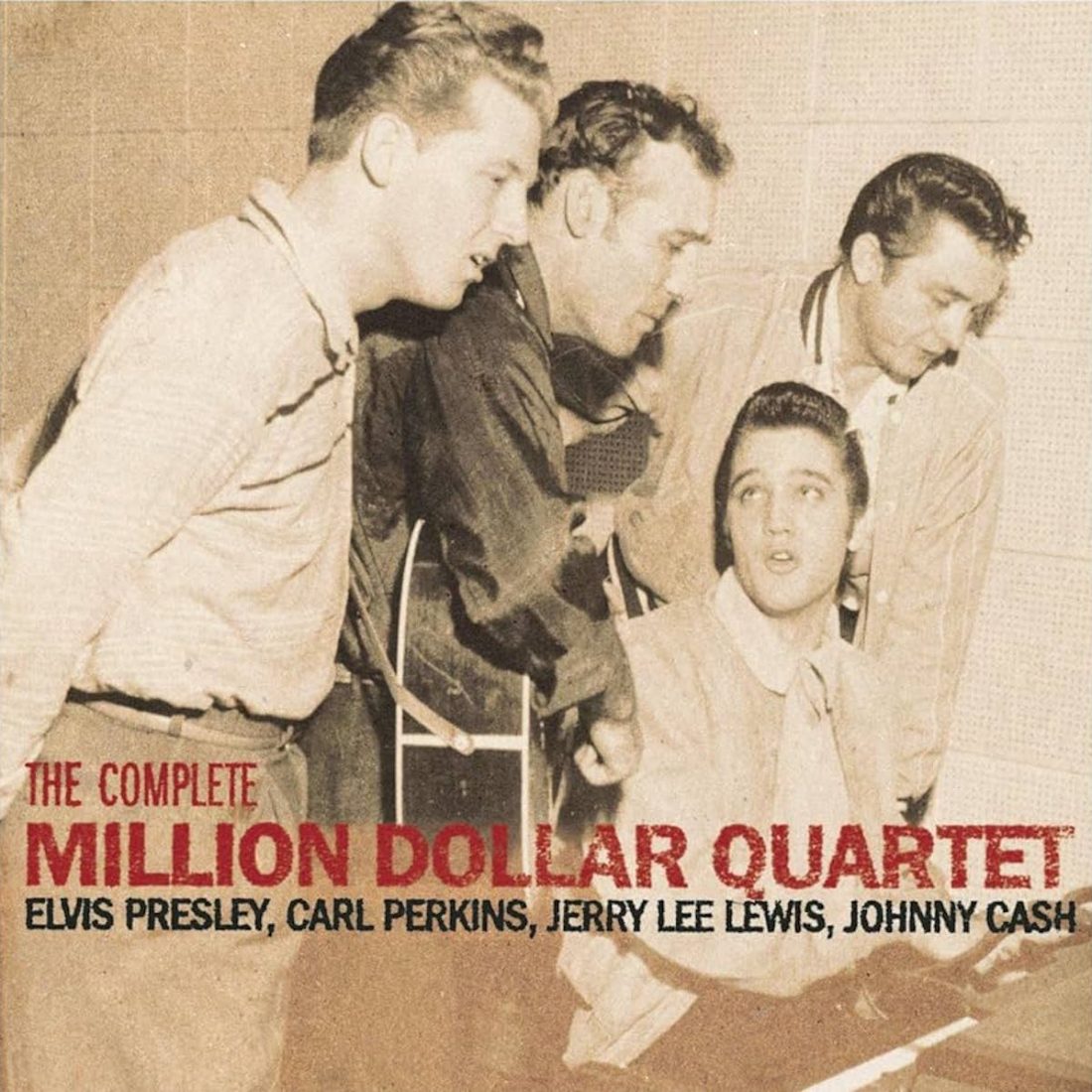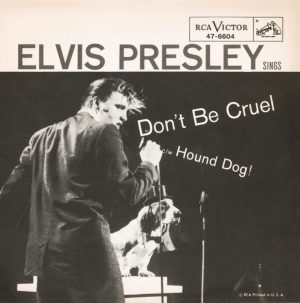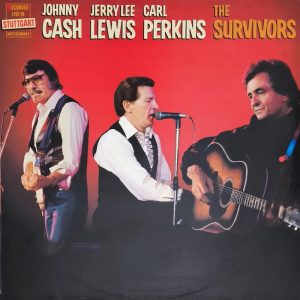On Tuesday 4 December 1956 history was made when the Million Dollar Quartet of Elvis Presley, Johnny Cash, Carl Perkins and Jerry Lee Lewis combined on a session that would one day bring riches…
Was it the world’s first supergroup… a prototype ‘open-mic’ session… or good ol’ boys having fun? However you want to dress it up, the Million Dollar Quartet’s one and only ‘performance’ on Tuesday 4 December 1956 made history, and a certain mystique continues to surround the event.
The get-together at the Memphis Recording Service studio, already history-bound thanks to hosting Elvis Presley’s first recording sessions, came at the end of a year in which Presley had turned the popular music world upside-down. Still just 21, he was now an RCA Victor artist. As music historian Hank Davis remarks, Sun Records boss Sam Phillips “was on a collision course with bankruptcy; selling Elvis’ contract was a way to forestall that”. The price RCA paid for the singer and his back catalogue was a then-astonishing $40,000. And payback came quickly; one out of every two discs RCA had pressed in the entire year of 1956 bore Elvis’ name.
Good Ol’ Boys Having Fun
Presley’s accomplices in the studio – Carl Perkins, Jerry Lee Lewis and Johnny Cash – were all current Sun acts, so Phillips’ cupboard was far from bare. Including an RCA artist in the would cause complications down the line, but that was not considered when the tape machine was set rolling by engineer ‘Cowboy’ Jack Clement.
Sun Records launched some of rock’n’roll’s most influential artists from the 18-foot by 33-foot room at 706 Union Avenue. That tiny space was a positive for Phillips: “I didn’t ever feel that I was being cheated by not having some of the set-ups I’d seen even then,” he said. “Doing what we did with what we had certainly did not hinder us. It could have been responsible for some of the original feel that we got.”
The ambience was that of a small-town schoolroom, with a linoleum floor and neutral-painted walls; any natural light from the street came via Phillips’ secretary Marion Keisker’s front office, to which it was connected via a door.
Will A Matchbox Hold My Clothes
All four singers involved were at very different points in their career. Presley, of course, was the hottest of hot properties, especially after national television exposure had sent Don’t Be Cruel/Hound Dog to No. 1 for 11 weeks; his second album (Elvis) was sitting at the top of the charts, while debut movie Love Me Tender had screened a fortnight earlier. Back in Memphis, he had dropped in to see old friend Carl Perkins.
Tennessee native Perkins had grown up in the cotton fields with dreams of making music, and auditioned for Sun in 1954 after hearing Presley’s rocked-up version of bluegrass standard Blue Moon Of Kentucky. Carl was soon opening shows for Elvis, and joined him in the charts when, early in 1956, the song Blue Suede Shoesbecame Sun’s first million-selling single. A serious car crash had halted his progress, but he now returned to the studio hoping to emulate his earlier success. He did so, too: Matchbox, recorded that day, would not only become his next hit but would later be covered by The Beatles.
Ferriday Fireball
Also taking part was pianist Jerry Lee Lewis, who’d auditioned for Sun the previous month. The forthcoming year would see him leap to prominence with hits like Whole Lotta Shakin’ Goin’ On and Great Balls Of Fire, but for now he was assisting Perkins at the request of Sam Phillips. Lewis was strapped for cash and, with Christmas fast approaching, was happy to lend a hand for the handsome session fee of $15.
Elvis had never met the tearaway from Ferriday, Louisiana, but was impressed. “I think he has a real future ahead of him… the way he plays piano just gets inside me.” The pair were less than a year apart in age, but Lewis was definitely the pretender to the throne.
As Jerry Lee recalls, he was the main centre of attention. “Elvis wanted to meet me. So he came and parked up right in front of Sun Records, in a white Lincoln Continental Mark II. He came in, we met, and he sat down next to the piano. We started singing, playing. Every time Johnny or Carl would try singing or doing something, Elvis would start singing!”
Walking The Line
Johnny Cash had given up his job selling electrical appliances door-to-door the previous year, and had been rewarded when I Walk The Line b/w Get Rhythm crossed over to the pop Top 20. Cash would soon become the first Sun artist to cut a long-playing record but, like Perkins, he would not be at the label long-term.
There is controversy as to whether Cash was actually present at the sessions, this leading one later issue of the music to be dubbed the Million Dollar Session (rather than Quartet). Some say Phillips summoned him to take part in the staged photo session, and that the absence of his trademark tones on tape indicates he did not take part. Further credence is given to the theory when Elvis says of That’s When Your Heartaches Begin that “a guy with a really deep voice” would have more success with it. During another song, On The Jericho Road, that demanded low notes, he says, “Take young Johnny Cash to do this one.”
Prototype ‘Open-Mic’ Session
Jack Clement, when quizzed on the subject in 2012, said: “You know, I really don’t remember… he might not have been there for very long that day, but I can’t really say.” Carl Perkins has recalled him leaving to do some Christmas shopping with first wife Vivian.
But Cash himself was adamant. “I was the first to arrive and the last to leave. I was there to watch Carl record, which he did until mid-afternoon when Elvis came in with his girlfriend. We started singing gospel, then some Bill Monroe. Elvis wanted to hear songs Bill had written besides Blue Moon Of Kentucky, and I knew the whole repertoire.
“I was farthest from the mic and was singing a lot higher than I usually did in order to stay in key with Elvis, but I guarantee you, I’m there.” Cash further claimed there is another, unheard tape of him performing with the group.
A Dilly Of A Shindig
Someone else whose involvement has been questioned is Sam Phillips himself. According to Clement: “Sam went next door to Taylor’s restaurant. Carl Perkins was in the studio recording. Everybody just started swapping stories and picking out songs, and I remember thinking I would be remiss if I didn’t record this. So I moved a few mics around.”
Far from having a problem with ceding control, Carl Perkins was “glad to see Elvis because by that time he was the biggest thing in the country. He’d just been out to Las Vegas and he was tellin’ us all about how exciting it was.”
So where did the Million Dollar Quartet name come from? The man to blame was Bob Johnson, entertainment editor of the Memphis Press Scimitar. He brought photographer George Pierce to capture all four performers along with 19-year-old Marilyn Evans, Elvis’ ladyfriend of the moment.
“I never had a better time than yesterday afternoon when I dropped in at Sam Phillips’ Sun Record bedlam on Union at Marshall,” Johnson’s feature began. “It was what you might call a barrelhouse of fun.”
A later comment states: “If Sam had been on his toes, he’d have turned the recorder on. That quartet could sell a million.”
A delighted Phillips quickly copied the article and circulated it to radio DJs to stir up interest. A breathless postscript read: “We thought you might like to read first-hand about our little shindig, it was a dilly!”
Sweetest Feeling
So what of the music itself? Carl Perkins and band are first to be heard, having been set up for their earlier session. Carl was accompanied by his regular musicians, including drummer WS Holland, who’d join Johnny Cash’s band in 1960. An untitled instrumental gives way to a minute of Love Me Tender, which could have been an invitation to the waiting Elvis to get involved (the song was No. 1 on Billboard’s chart). Instrumental versions of Jingle Bells and White Christmas then remind us we are approaching the festive season.
A romp through Lowell Fulson’s bluesy Reconsider Baby is where Elvis first becomes evident, with sprightly support from Jerry Lee Lewis’ piano and WS Holland’s galloping drums (he would record the song officially in 1960 when casting around for material to relaunch his post-Army career). Elvis then prefaces a version of his own Don’t Be Cruel with a description of Jackie Wilson, who he’d seen performing a version of the song in Las Vegas. His verdict: “He got much better, boy, much better than that record of mine.”
Jerry’s Boogie
Presley said he wished he’d recorded Paralyzed at a slower tempo, similar to the way Wilson sang Don’t Be Cruel, then tried the song, a standout of just-released second album Elvis, in that style. (He remained an admirer and, when Wilson suffered a stroke on stage in New Jersey in 1975, contributed $30,000 to his hospital expenses.)
Carl Perkins shared a microphone with the King – but since Jerry Lee Lewis had a mic to himself, he became more prominent as the session progressed. Lewis’ contributions included country legend Gene Autry’s song You’re The Only Star (In My Blue Heaven) and the instrumental Jerry’s Boogie. Elvis responded to a snatch of just-released Sun debut Crazy Arms with “The wrong man’s been sittin’ here at this piano.” “Well I been wantin’ to tell you that!” exploded the Killer. “Scoot over…”
Sun’s Golden Era
After his Christmas break, Elvis Presley would head for Hollywood. Among the tracks cut for RCA were three songs tried out during the December session: Peace In The Valley, Is It So Strange and That’s When Your Heartaches Begin.
The Million Dollar Quartet tapes were destined to remain in obscurity for over two decades; Jack Clement committed to making acetate discs for all those involved, but reckons he forgot to do so (he may be mistaken, as one ended up in the Graceland record collection).
In 1969, when Sun Records and its back catalogue was sold to Shelby Singleton, it’s unlikely the session even registered in Sam Phillips’ memory. Certainly Singleton, hot from producing Jeannie C Riley’s country smash Harper Valley PTA, had no knowledge of it when he started trawling through an estimated 10,000 hours of recording tape looking for unreleased music.
That task was accelerated by Elvis’ death in 1977, when demand for music by the King hit an all-time high. When the session’s existence leaked, an inevitable court battle began with RCA, Cash and Perkins all claiming ownership. After a settlement, the first of several versions of the Million Dollar Quartet appeared via Charly Records in 1981, a 35-minute religious-themed selection. French label Charly was chosen because the music cut in Sun’s golden era had enjoyed a renaissance in Europe.
World’s First Supergroup?
As more material came to light the set reappeared as The Complete Million Dollar Session (Charly, 1987) and Elvis Presley – The Million Dollar Quartet (RCA, 1990); both had 40 tracks. Sony BMG’s 50th anniversary edition added a further 12 minutes of unheard recordings, located in an archive at Graceland by Ernst Jorgensen. This included Jerry Lee and Elvis trading vocals on Jesus Walked That Lonesome Valley.
Could there be more still to come from the five-hour session? “We found three reels,” noted Presley historian Jorgensen. “You could always argue that there were more, but in the first you can hear Elvis arriving and in the last you can hear him leaving. I doubt that there are more.” The superior sound quality of this 79-minute release, courtesy of audio expert Kevan Budd, suggests it will remain the definitive recording.
Carl Perkins remembers Sam Phillips playing him snippets the next day. “I had no idea there was so much of it. It sounds a lot better than I thought it would. Looking back on it now, it was probably one of the highlights of my time at Sun.” He and Jerry Lee Lewis guested on a Johnny Cash concert in 1981 that was released as The Survivors Live. This was followed by the Memphis-recorded Class Of 55 album, issued in 1986, that saw Roy Orbison take the place of Presley. Ironically, contractual matters once again threatened release; producer Chips Moman shelled out $100,000 to guarantee Johnny Cash’s appearance on the finished product. A TV special aired four years later, while a companion album of interviews earned a spoken-word Grammy.
All Gone
The Million Dollar Quartet performers are no longer with us: Carl Perkins, Johnny Cash and Jerry Lee Lewis took their final curtain calls in 1998, 2003 and 2022 respectively. While Sam Phillips passed in 2003 and engineer Jack Clement in 2013.
As Elvis was leaving the studio on that historic December Tuesday, he smilingly remarked: “That’s why I hate to get started in these jam sessions. I’m always the last one to leave.” His fame – and the influence of Colonel Parker – would ensure this remained a one-off occasion.
Buy the The Complete Million Dollar Quartet here
Read More: The Vintage Rock Top 101 Rockabilly Tracks











